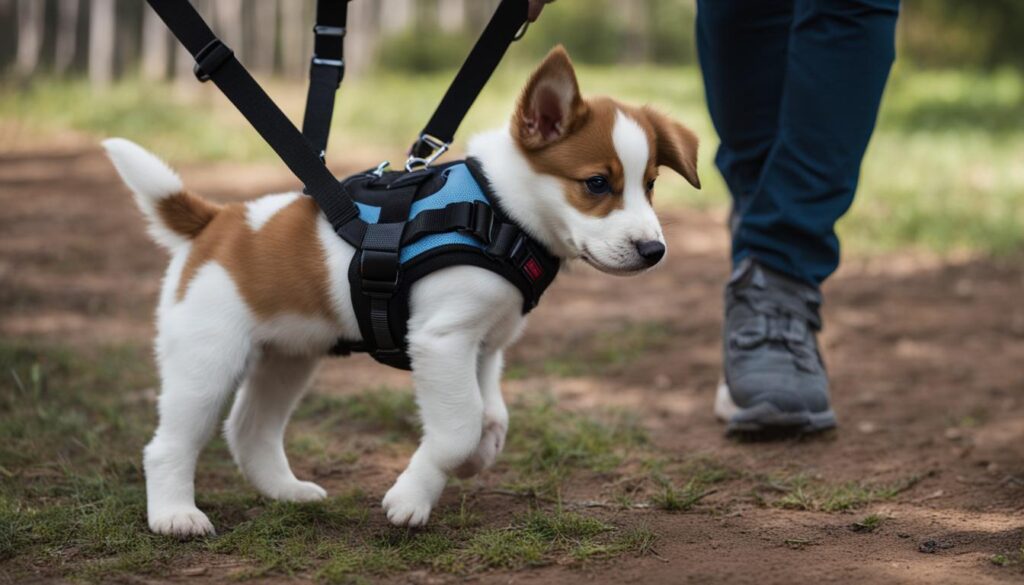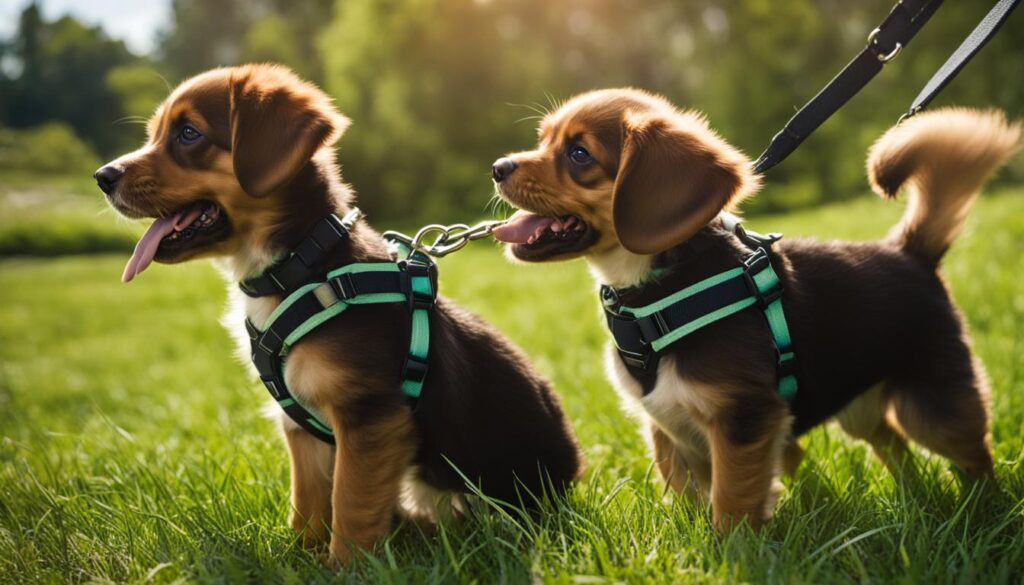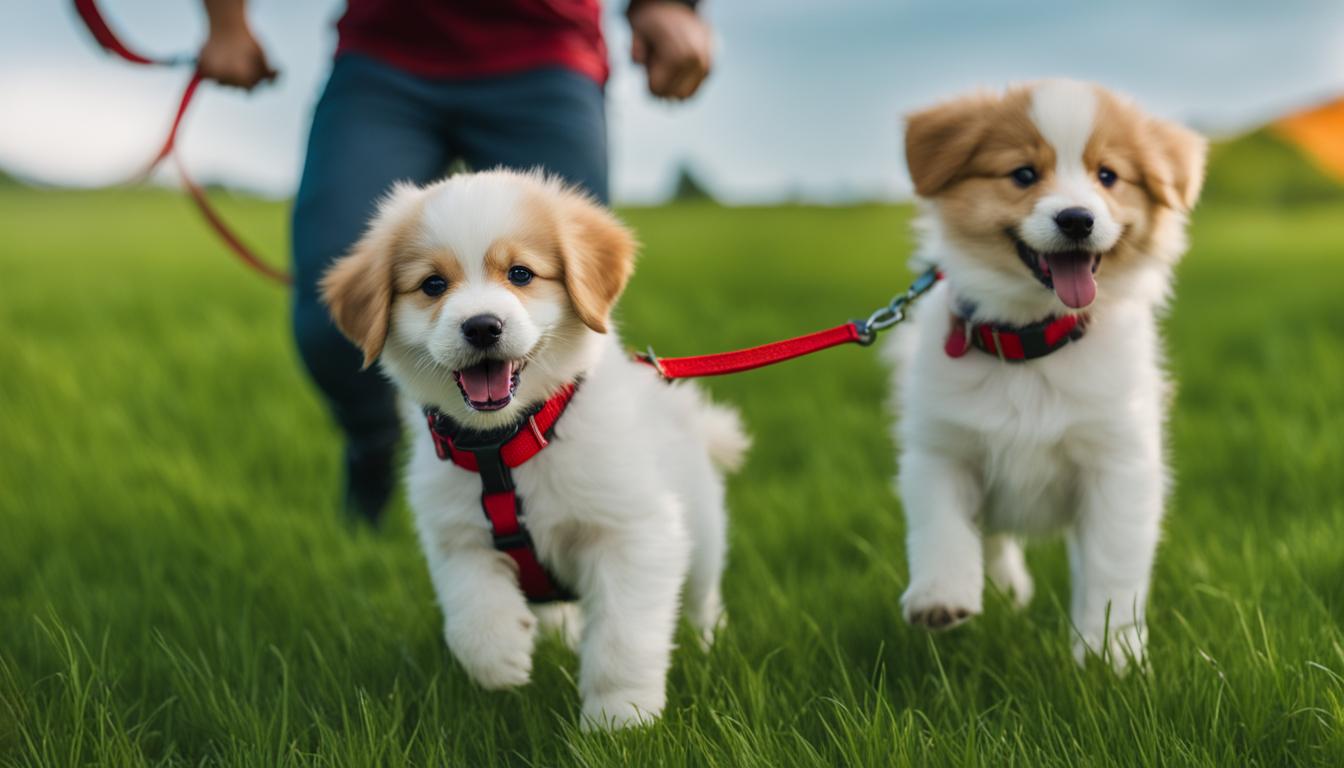When it comes to training your new puppy, choosing the right equipment is essential for their safety and well-being. One question that pet owners often grapple with is whether to use a collar or harness. I will explore the debate between using a collar or a harness for puppies and determine which option is the best choice. We will discuss the benefits and drawbacks of both collars and harnesses and guide on selecting the right equipment for your puppy's needs. By the end I am sure, you will have a clear understanding of whether a collar or a harness is the better option for your furry friend.
- Choosing the right training equipment is crucial for your puppy's safety and well-being.
- The debate between using a collar or a harness for puppies is a common concern for pet owners.
- Both collars and harnesses have their benefits and drawbacks.
- Consider your puppy's specific needs when selecting the right equipment.
- By the end of this section, you will have a clear understanding of the best choice for your puppy.
Understanding Puppy Training Equipment: Collar or Harness Options
In this section, we will delve into the different options available for puppy training equipment, specifically collars and harnesses. Training equipment is essential for teaching your puppy good behavior, ensuring their safety, and establishing control during walks and outings.
Overview of Collar Types for Puppies
Collars are a popular choice for puppy training and come in various types to suit different needs. Let's explore some of the collar options available:
- Flat or Rolled Collars: These classic collars are made from nylon, leather, or fabric. They are comfortable for daily wear and easy to clip a leash onto.
- Choke Collars: Also known as slip collars, these collars tighten when you pull the leash, correcting your puppy's behavior. However, they should be used with caution and under professional guidance.
- Prong Collars: These collars have metal prongs that apply gentle pressure around your puppy's neck. They are designed to mimic a mother dog's correction. Like choke collars, prong collars should be used responsibly and with appropriate training.
- Martingale Collars: Martingale collars are specifically designed for dogs that tend to escape from traditional flat collars. They have a limited-closure design that prevents your puppy from slipping out.
- Safety Collars: Safety collars have a quick-release mechanism that allows them to easily come off in case your puppy gets caught on something, preventing choking hazards.
Diving Into Harness Varieties for Small Dogs
Harnesses offer an alternative to collars for puppy training and provide added comfort and control. Here are some harness varieties suitable for small dogs:
- Back-Clip Harnesses: Back-clip harnesses have a D-ring attachment on the back, distributing the leash's pulling force across your puppy's body and reducing neck strain. They are suitable for most puppies and provide good control during walks.
- Front-Clip Harnesses: Front-clip harnesses have a front D-ring attachment that redirects your puppy's pulling motion toward you, encouraging good walking behavior. They offer excellent control and are ideal for puppies that need more training or have a tendency to pull.
Choosing between a collar and a harness depends on your puppy's individual needs, behavior, and specific training goals. By considering the advantages and limitations of each option, you can select the appropriate equipment to ensure effective training and comfort for your furry friend.
Assessing the Pros and Cons of Collars for Puppies
In this section, I will evaluate the pros and cons of using collars for puppies. Collars are a popular choice for many dog owners due to their ease of use, affordability, and practicality. Let's take a closer look at the benefits of using a collar for your furry friend.
The Pros of Using a Collar for a Puppy:
- Ease of Use: Collars are simple to put on and take off, making them convenient for everyday use.
- Affordability: Collars are generally more budget-friendly than harnesses, making them a cost-effective option.
- ID Tag Display: Collars provide a reliable way to display identification tags, allowing for easy identification of your puppy if they ever get lost.
While collars offer several advantages, it's important to also consider the potential drawbacks of using a collar for your puppy.
The Cons of Using a Collar for a Puppy:
- Tracheal Collapse Risk: Puppies have delicate necks, and the use of collars can put pressure on their trachea, leading to potential health issues.
- Eye Pressure Increase: Collars that are too tight can cause pressure on the eyes, leading to discomfort and potential eye problems in puppies.
- Discomfort during Leash Training: Puppies who are learning to walk on a leash may find collars uncomfortable and restrictive, affecting their confidence and progress.
It's essential to weigh the pros and cons carefully when deciding whether to use a collar for your puppy. Consider your puppy's breed, size, and individual needs to make an informed choice.
Evaluating the Advantages and Disadvantages of Harnesses for Puppies


In this section, we will explore the advantages and disadvantages of using harnesses for puppies. Harnesses offer several benefits that make them a popular choice among dog owners. One major advantage is the reduction of neck pressure and potential injuries compared to collars. Let's take a closer look at the different types of harnesses and their benefits.
Reducing Neck Pressure with Back-Clip Harnesses
Back-clip harnesses are designed with a D-ring on the back, which helps distribute the leash's tension across the puppy's body. This placement reduces the strain on their neck, making it a safer option for puppies with a delicate trachea or those prone to pulling. By using a back-clip harness, you can provide your puppy with a comfortable and secure walking experience without putting unnecessary pressure on their neck.
Control and Training Aids: Front-Clip Harnesses
Front-clip harnesses have a D-ring located in the front, which can help with control and training. When your puppy pulls on the leash, the front-clip harness redirects their attention towards you, discouraging pulling behavior and promoting loose leash walking. This type of harness provides you with more control over your puppy's movements, allowing for better training sessions and walks.
Harnesses offer a safer alternative to collars for puppies, reducing the risk of neck injuries and discomfort.
While harnesses provide numerous advantages, it's important to consider a few potential drawbacks. One of these is the need for proper fitting. It's crucial to choose a harness that fits your puppy correctly to ensure comfort and effectiveness. Additionally, some puppy owners may find front-clip harnesses slightly more challenging to put on and take off compared to collars. However, with practice and patience, these challenges can be overcome, and the benefits of using a harness for your puppy will far outweigh any initial difficulties.
| Advantages of a Harness for Puppies | Disadvantages of a Harness for Puppies |
|---|---|
| Reduces neck pressure and potential injuries | Proper fitting is crucial |
| Provides better control | Slightly more challenging to put on and take off |
| Serves as a training aid |
By the end of this section, you will have a clear understanding of the benefits and challenges of using harnesses for puppy training. Harnesses offer a safer alternative to collars, reducing the risk of neck injuries and discomfort for your furry friend. Whether you opt for a back-clip harness to minimize neck pressure or a front-clip harness to enhance control and training, harnesses are an excellent choice for ensuring your puppy's well-being during walks and training sessions.
Is a Collar or Harness Better for a Puppy?


When it comes to training your puppy, one crucial decision to make is whether to use a collar or a harness. Both options have their benefits and considerations, so it's important to understand the differences and choose the one that best suits your puppy's needs.
Using a collar for puppy training offers several advantages. Collars are generally more affordable and easier to use than harnesses. They provide a secure way to attach identification tags, which are essential for ensuring your puppy's safety. However, it's important to note that collars can put pressure on a puppy's delicate neck and may cause discomfort or potential health issues, especially if used incorrectly or inappropriately.
Harnesses, on the other hand, offer a different set of advantages. They distribute the pulling force across a puppy's chest, reducing the risk of neck injuries. Harnesses provide more control and are particularly beneficial for puppies that haven't mastered leash walking. However, harnesses may require more adjustments and can take longer to put on and take off compared to collars.
When deciding between a collar and a harness, consider the following factors:
- Comfort: Assess which option is more comfortable for your puppy based on their size, breed, and individual preferences.
- Safety: Consider the potential risks associated with each option and choose the one that minimizes the risk of injury to your puppy.
- Control: Determine which option provides better control during walks and training sessions.
- Training Effectiveness: Evaluate how each option impacts your puppy's training progress and ability to learn commands.
To help you make a more informed decision, let's compare collars and harnesses for puppy training:
| Collar | Harness |
|---|---|
| Easy to use | Distributes pulling force |
| Affordable | Better control |
| Suitable for displaying ID tags | Reduces risk of neck injuries |
| Potential discomfort and health issues | May require more adjustments |
Keep in mind that every puppy is unique, so what works for one may not work for another. It's essential to consider your puppy's specific needs, breed characteristics, and training requirements when making your decision.
Remember, whether you choose a collar or a harness for your puppy, patience, consistency, and positive reinforcement are key to successful training.
Collar Versus Harness for Puppy Training: Making the Informed Decision


When it comes to puppy training equipment, the choice between a collar or a harness can be a tough decision for pet owners. In this section, we will dive deeper into the decision-making process and help you make an informed choice for your furry friend.
The Role of Breed and Size in Training Equipment Selection
When selecting training equipment for your puppy, it's important to consider their breed and size. Different breeds have varying neck and body structures, which can affect the suitability of collars or harnesses. For example, small breeds with delicate necks may benefit from the comfort and support offered by a harness. On the other hand, larger breeds with sturdy necks may find a collar more appropriate for effective control during training sessions.
Size also plays a role in determining the best training equipment. Puppies that are still growing may require adjustable collars or harnesses that can accommodate their changing sizes. Additionally, the weight distribution of a harness can be beneficial for puppies with a tendency to pull on the leash, as it reduces strain on their necks and prevents potential injuries.
Comparative Analysis of Training Collars and Harnesses
Now, let's take a closer look at the key factors to consider when deciding between a collar or a harness for puppy training. Below is a table that compares the features and benefits of each option:
As we can see from the table, both collars and harnesses offer unique advantages. Collars are often more affordable, easier to put on, and ideal for displaying identification tags. On the other hand, harnesses distribute weight more evenly, provide better control, and reduce the risk of injury, making them a great option for dogs prone to pulling or those with respiratory issues.
Ultimately, the choice between a collar and a harness depends on your puppy's individual needs and training goals. Consider consulting with a professional trainer or veterinarian to ensure you make the best decision for your furry friend's well-being.
Now that we've explored the role of breed and size in training equipment selection and provided a comparative analysis of training collars and harnesses, you are well-equipped to make an informed decision. Keep in mind that the comfort and safety of your puppy should be the top priority when selecting their training equipment.
Customizing the Fit: How to Choose the Right Equipment for Your Puppy's Needs
When it comes to selecting the right collar or harness for your furry friend, it's essential to consider their specific needs. Choosing the correct equipment plays a crucial role in ensuring your puppy's comfort, safety, and overall well-being during training and daily walks.
Here are some important factors to consider when choosing the perfect collar or harness:
- Size: Measure your puppy's neck or chest circumference to determine the appropriate size. Avoid selecting equipment that is too loose or too tight, as it may cause discomfort or limit movement.
- Adjustability: Look for collars or harnesses that are easily adjustable to accommodate your puppy's growth. This feature allows you to customize the fit as your puppy develops and ensures a snug yet comfortable fit.
- Comfort: Prioritize your puppy's comfort by choosing soft and lightweight materials. Consider options with padding or breathable fabrics to prevent chafing or irritation during extended use.
Once you have selected the appropriate collar or harness, proper fitting is crucial for your puppy's safety and well-being. Here are a few tips for a secure fit:
- Adjust the collar or harness to ensure a snug fit without causing any discomfort or restriction.
- Make sure you can fit two fingers comfortably between your puppy's neck or chest and the equipment. This provides enough room for breathing and movement.
- Regularly check the fit to accommodate your puppy's growth. Adjust the straps accordingly to maintain a secure and comfortable fit as your puppy matures.
By considering these important factors and following proper fitting techniques, you can choose the right collar or harness that meets your puppy's unique requirements. This ensures a positive training experience and promotes a strong bond between you and your furry companion.
Conclusion – Is a Collar or Harness Better for a Puppy?
In conclusion, the debate between using a collar or a harness for puppies has been thoroughly explored. Both options have their own benefits and drawbacks, and the choice ultimately depends on your puppy's individual needs and training goals. When making your decision, it is crucial to prioritize comfort and safety.
Incorporating Comfort and Safety in Your Choice
Comfort should be a top consideration when selecting a collar or a harness for your puppy. Ensure that the chosen equipment fits properly and does not cause any discomfort or irritation. Additionally, take into account the materials used and opt for soft, non-abrasive fabrics to prevent chafing.
Furthermore, safety should always be a priority. Choose a collar or harness that allows for easy attachment of identification tags, ensuring the return of your puppy in case they venture too far. Avoid collars that put excessive pressure on the neck or harnesses that restrict natural movement.
Puppy Growth Considerations: Adjusting Collars and Harnesses
As your puppy grows, it is important to regularly assess and adjust the fit of their collar or harness. Puppies grow quickly, and ill-fitting equipment can cause discomfort or pose safety risks. Ensure that the collar or harness can be easily adjusted to accommodate your puppy's changing size to maintain both comfort and effectiveness.
It is recommended to measure your puppy's neck or chest regularly and make necessary adjustments accordingly. Whether you choose a collar or a harness, it is crucial to periodically check the fit to guarantee your puppy's well-being and prevent any potential issues.
By considering comfort, safety, and growth considerations, you will be able to make an informed decision on whether a collar or a harness is the better choice for your puppy. Remember, every puppy is unique, so choose the option that best suits their individual needs and enhances their training experience.
FAQ – a collar or a harness?
What is the best choice for a puppy – a collar or a harness?
The best choice for a puppy depends on various factors, including the puppy's size, breed, and individual needs. Both collars and harnesses have their advantages and disadvantages, so it's important to consider these factors before making a decision.
What are the different types of collars suitable for puppies?
There are several types of collars suitable for puppies, including flat or rolled collars, choke collars, prong collars, martingale collars, and safety collars. Each type has its purpose and level of control.
What are the different varieties of harnesses for small dogs?
There are different varieties of harnesses designed for small dogs, such as back-clip harnesses and front-clip harnesses. Back-clip harnesses reduce neck pressure and potential injuries, while front-clip harnesses provide better control and can serve as training aids.
What are the pros and cons of using collars for puppies?
Collars are easy to use, affordable, and suitable for displaying ID tags. However, they can pose a risk of tracheal collapse, increase eye pressure, and cause discomfort for puppies learning to walk on a leash.
What are the advantages and disadvantages of using harnesses for puppies?
Harnesses can reduce neck pressure and potential injuries compared to collars. Back-clip harnesses are particularly effective in minimizing strain on the neck. However, harnesses may require proper fitting and can be more challenging to put on and take off.
Which is better for a puppy – a collar or a harness?
The choice between a collar and a harness depends on factors such as comfort, safety, control, and training effectiveness. It's essential to consider your puppy's needs and consult with a professional for guidance on selecting the most suitable option.
How do breed and size factor into choosing training equipment?
Breed and size play a significant role in selecting training equipment for puppies. Different breeds may have different needs and considerations, so it's important to choose equipment that is appropriate for your puppy's breed and size.
How do I choose the right collar or harness for my puppy?
When choosing a collar or harness for your puppy, factors such as size, adjustability, and comfort should be considered. It's crucial to ensure proper fitting and adjustability to guarantee the safety and well-being of your puppy during training.
Should I adjust collars and harnesses as my puppy grows?
Yes, it's important to regularly adjust collars and harnesses as your puppy grows to ensure proper fit and prevent discomfort. Puppies grow quickly, and their training equipment should always be adjusted accordingly.





